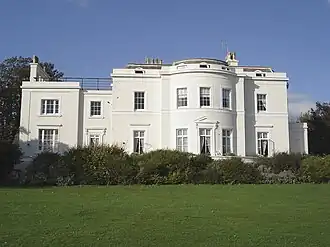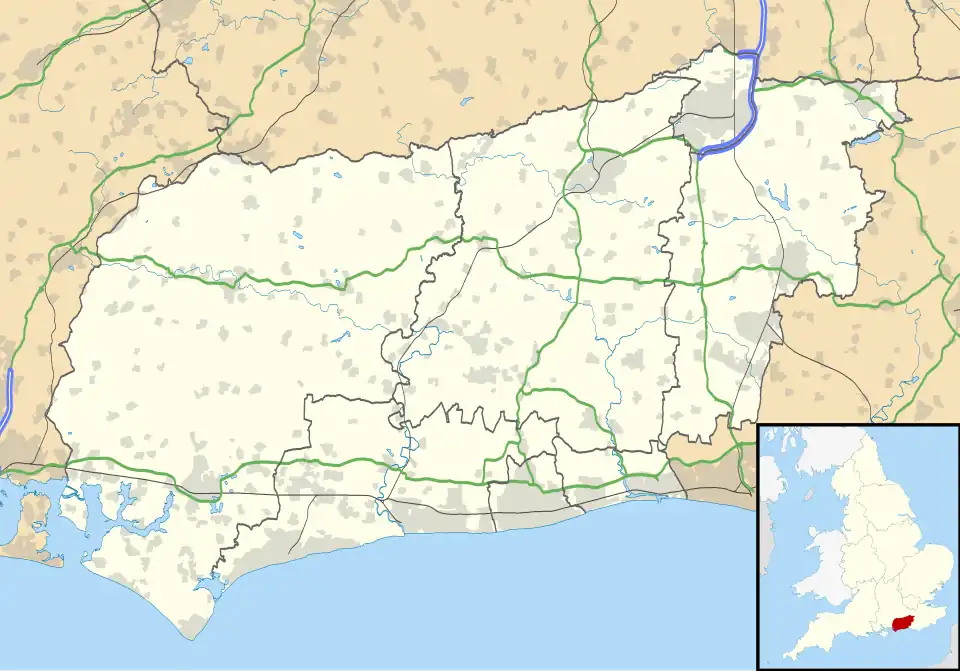Beach House, Worthing
| Beach House | |
|---|---|
 A view of the rear of Beach House, taken from Beach House grounds | |
 Location within West Sussex | |
| Former names | Marino Mansion |
| General information | |
| Architectural style | Regency |
| Location | Worthing, West Sussex, England |
| Coordinates | 50°48′43″N 0°21′46″W / 50.8119°N 0.3627°W |
| Year(s) built | 1820 |
| Client | Robert Carey Elwes |
| Design and construction | |
| Architect(s) | John Rebecca |
Listed Building – Grade II* | |
| Official name | Beach House |
| Designated | 3 August 1948 |
| Reference no. | 1025808 |
Beach House in Worthing, England is a Regency beach-side villa, built in 1820 to designs by John Rebecca. It was originally known as Marino Mansion. It was built for a man named Robert Cary Elwes.[1]
History
In the mid-19th century, Sir Frederick Adair Roe, Chief Magistrate of the Bow Street office and head of the Bow Street Runners, London's police force, owned and lived in Beach House.
Sir Robert Loder, Conservative Member of Parliament for New Shoreham, lived at Beach House until his death in 1888. His wife, Lady Maria Georgiana Loder and his eldest son Sir Edmund Loder continued to live at Beach House after Sir Robert's death.
Between 1907 and 1910, King Edward VII stayed at the house several times while visiting Sir Edmund Loder and his family.
In 1917 playwright Edward Knoblock bought the house. His visitors included Arnold Bennett, J. B. Priestley, and Sir Compton Mackenzie. Knoblock refurbished the interior and forecourt of the property to the designs of Scottish architect Ormrod Maxwell Ayrton, while displaying furniture from the Thomas Hope collection he had bought from a sale at Deepdene in Dorking, Surrey.[2]
During the Spanish Civil War in 1936, Beach House was used to house children evacuated from their homes in the Basque province of Biscay. The children were fleeing bombing and starvation after the destruction of the town of Guernica by the Nazi Luftwaffe. They were supported and cared for entirely by local volunteers.[3]
From 1939 to 1945, during the Second World War, Beach House was used by the Air Training Corps.
Beach House was designated a Grade II* listed building in 1948.[4]
The grounds
The beach-side open space surrounding the Regency building of Beach House is situated on Brighton Road and was purchased by Worthing Borough Council in December 1927 and laid out in 1937–38. The grounds are 2.78 acres (1.13 ha) and have a playground, two tennis courts and a car park.[5][6] Beach House gives its name to nearby Beach House Park, opposite Beach House, one of the world's best-known venues for bowls.
See also
References
- ^ "Worthing Borough Council - Planning and Building Control". Archived from the original on 28 September 2007. Retrieved 22 August 2007.
- ^ The DiCamillo Companion - Database: History, Gardens, Movies Archived 11 October 2007 at the Wayback Machine
- ^ "Worthing Borough Council plaques". Open Plaques. Archived from the original on 5 September 2012. Retrieved 22 May 2022.
- ^ Historic England. "Beach House (1025808)". National Heritage List for England. Retrieved 29 July 2025.
- ^ Beach House Grounds Archived 1 March 2007 at the Wayback Machine
- ^ "Beach House Grounds". Adur & Worthing Councils. Retrieved 29 July 2025.